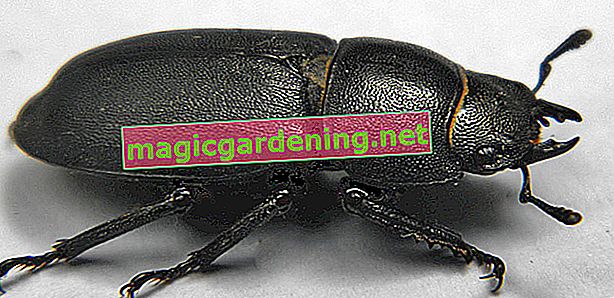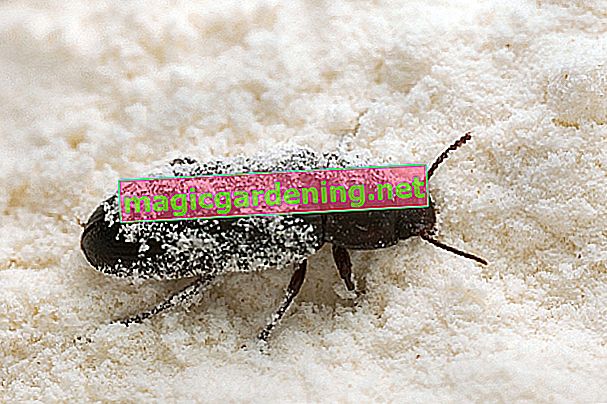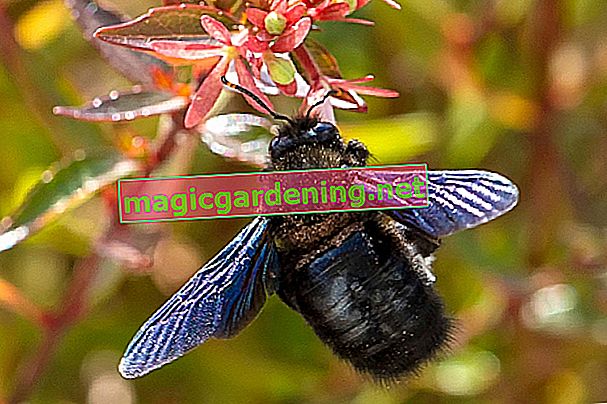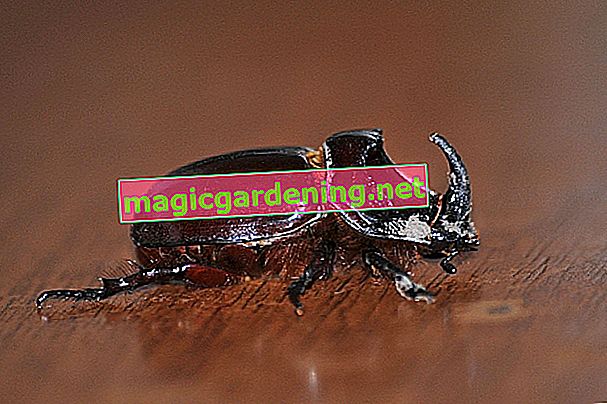
Common black beetles
There are numerous black beetles, but only a few are culture followers and settle in human dwellings. Many of them are not pests, but only become a nuisance in large numbers. Depending on the species, the beetles reach a size between 10 and 80 millimeters. Although many of these species have wings, they can rarely be seen in flight.
also read
- Larkspur - great diversity of species and varieties
- Beetles in the garden - tips on beneficial insects and pests
- Bay damage on the cherry laurel: this beetle is to blame
Longhorn beetle
Beetles with long antennae belong to the longhorn family. Their antennae are longer than the body, which is usually elongated and flat. Many species feed on flower parts, pollen or tree sap. Others eat fresh bark, leaves or stems from herbaceous plants and trees. However, the majority of all longhorn beetle larvae feed on wood, whereby the condition of the wood plays an important role. Not every longhorn beetle is a wood pest, because many larvae only eat dead wood.
- Large oak buck : black-brown, larvae eat heartwood of old oaks
- Small oak buck : solid black, larvae decompose wood of various deciduous trees
- House buck : brown to black, larvae eat dead coniferous wood and construction timber
Schröter
A black beetle with pincers is unmistakable. This stag beetle is a successful cultural successor and, like the Balkenschröter, belongs to the Schröter family. Most of the species in this family are wingless when fully grown and no longer eat. The larvae, which live mainly in the dead wood, form the feeding stage. Some Schröter are attracted by artificial light sources and occasionally get lost in the apartment.
Characteristics:
- between eight millimeters and nine centimeters tall
- variable color: brick-red, red-brown or black
- Males often with showy mouthparts
Dung beetles
These beetles are between ten and 45 millimeters long and can be dark brown, purple or black in color. Their bodies often have a metallic sheen. The wood dung beetle is a common species that crawls across the forest floor or can be found in the garden. The animals appear clumsy in flight. Since they feed on the dung of other animals, they are considered to be important decomposers in the natural ecosystem.
Digression
Impressive orientation
The vine cutter (Lethrus apterus) is a dung beetle that belongs to the subfamily Lethrinae. It occurs in the extreme south-east of Central Europe and has amazed researchers. When the nocturnal beetles leave their breeding chamber to look for food sources, they orient themselves to the starlight. To do this, they stand on a ball of dung and turn in their own vertical axis. You remember the image of the night sky with its light sources like a snapshot.Black beetle

A distant relative of shredders and dung beetles that can fly is the meal beetle. It belongs to the family of black beetles, who prefer warm habitats and often appear as cultural followers. Therefore, they are often found close to humans.
Black beetles are between one and 50 millimeters long and have a variable body structure. That makes them easily confused with other beetles. Most species are completely black or blackish brown. There are beetles with a rusty yellow or brown color.
| scientific | habitat | food | pest | size | |
|---|---|---|---|---|---|
| Big dead beetle | Blaps mortisaga | in dark places in cellars, barns and stables | decompose organic material | No | 2 to 3 cm |
| Flour beetle | Tenebrio molitor | Mulm, rotting wood and bird nests, flour and grain | Insectivores, feed on starch | Yes | 1 to 2 cm |
| Beam shredder | Dorcus parallelipipedus | Deciduous forests and orchards with mature trees | feed on tree sap | No | 1 to 3 cm |
| Stag beetle | Lucanus cervus | warm open landscapes | suck plant juices | No | Males 3 to 8 cm, females 3 to 5 cm |
| Wood dung beetle | Anoplotrupes stercorosus | Beech forests, gardens | breaks down feces, eats mushrooms and sucks tree sap | No | 1 to 2 cm |
Flying black beetle in the garden?

The supposed beetle is often the blue-black wooden bee, which is unmistakable with its blue wings. It is the largest wild bee that you can see in Germany. It comes out of its winter quarters in spring with the first warm rays of sunshine and looks for food on nectar-rich flowering plants.
What wooden bees like:
- Peas, garden honeysuckle and rosemary
- dead tree trunks
- sunlit places
Where the beetles can appear
Animals that benefit from numerous advantages due to the changes in the landscape made by humans are called cultural followers. You will find better sources of food, safe retreats and warm winter quarters. Therefore, like many black beetles, these animals follow humans and settle in cultivated landscapes and buildings.
Black beetles belong to different families and have different ways of life. Your food spectrum is accordingly varied.
In the garden
Most species prefer varied habitats in which plants, shrubs and trees provide food. Dead wood ensures a safe place of retreat and space to overwinter. In addition, many beetles lay their eggs in the rotten wood. Dark niches under piles of stones or wooden pallets are also popular with various beetles.
Tips
With a natural garden that is as diverse as possible, you can offer endangered species a habitat. Even small areas that are left to their own devices are sufficient.
In the house

If you find a black bug in your home, don't panic. Most species got into the building by chance through open windows because they were attracted by light sources.
Species like the great dead beetle prefer dark and undisturbed areas like basements and barns. In nature, they often live in the structures of various mammals. Wood-dwelling larvae of longhorn beetles are difficult to spot. They usually have a development period of several years and are also rarely seen as an adult insect in the house.
Fight black beetles?
Before taking any action to combat it, you should precisely identify the species. Not every beetle is considered a pest. Many insects are useful as they clear and decompose organic matter and debris. Specifying a species is also important because not every black beetle becomes a nuisance, but is subject to legal protection.
| specially protected | frequency | ||||
|---|---|---|---|---|---|
| Big dead beetle | No | still often, probably going back | |||
| Flour beetle | No | one of the most common culture followers | |||
| Beam shredder | Yes | not endangered | |||
| Stag beetle | Yes | endangered | |||
| Wood dung beetle | No | frequently | |||
| Big oak buck | Yes | threatened with extinction | |||
| Little oak buck | Yes | often, decreases sharply locally | |||
| House buck | No | frequently | |||
| Blue-black wooden bee | No | often in warm regions |
Fight black beetles
The meal beetle occurs less and less as a stored product. The species can reproduce well in buildings that were formerly used as storage facilities for grain. The beetles are extremely nimble and look for suitable places in the apartment to lay their eggs. They hide in dark niches or between pipes under ceilings. Flour, spaghetti, and bird seeds are ideal sources of food.
How to control flour beetles:
- Clean cupboards and drawers
- Vacuum niches behind the stove and furniture
- Store vacuum cleaner bags in a sealed plastic bag
- Dispose of contaminated food
- If an infection is suspected, food can be saved by freezing
Tips
Pheromone traps have an attractive effect on the beetles. It can be that the crawlers develop into a nuisance even faster.
frequently asked Questions
Are there big black beetles with blue wings?
The blue-black wooden bee hides behind the supposed beetle with the striking wing color. It has little in common with the beetles. The impressive insect is the largest native wild bee species. It can be seen looking for food in spring. Flowering plants rich in nectar are ideal sources of energy.
What is the name of the big black beetle with tongs?
If you spot such a beetle in your garden, consider yourself lucky. You probably found a stag beetle. Only the males develop these showy mouthparts. However, they no longer have a function, because the animal cannot look after itself. The female helps the partner by enlarging wounds in the bark of oak trees. The beetles then suck up the exuding sap.
Which black beetles have long antennae?
Noticeably long antennae are typical of the longhorn beetle species. The antennae usually exceed the body size, which makes these beetles unmistakable. However, their coloring is variable. Not every longhorn beetle is colored black. Most species are iridescent in color, with the color palette ranging from blood red to blue to metallic green.
Which beetle native to Germany is the largest?
Beetles in Central Europe can grow to between two millimeters and eight centimeters. The stag beetle is the largest of the native species of beetle. The females are three to five centimeters smaller than the males. These can be up to eight inches long. This body size can be larger than a species from the longhorn family. At 17 centimeters, the giant longhorn beetle is the world's largest species of beetle. However, this occurs in Brazil.
How can I tell the difference between black beetles?
Look at pictures on destination portals. Large beetles can be identified quite easily because they usually develop conspicuous body features. The body shape, antennae and wing covers can be used to identify the family. To determine the exact species, it may be necessary to take a closer look at the limbs, pronotum or mouthparts.








